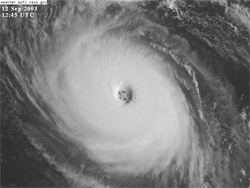 June 1 was the official start of the Atlantic hurricane season and activity typically peaks in August. According to the National Oceanic and Atmospheric Administration’s (NOAA) Atlantic Hurricane Season Outlook, a near normal Atlantic hurricane season is expected. The forecasters predict a 70 percent chance of nine to 14 named storms (tropical storms are named when their sustained maximum winds reach 30 mph), with four to seven of those storms having the potential to become hurricanes. At least one storm—and possibly two or three storms—will likely reach Category 3 (or higher) status. Category 3 storms punch sustained winds greater than 111 mph.
June 1 was the official start of the Atlantic hurricane season and activity typically peaks in August. According to the National Oceanic and Atmospheric Administration’s (NOAA) Atlantic Hurricane Season Outlook, a near normal Atlantic hurricane season is expected. The forecasters predict a 70 percent chance of nine to 14 named storms (tropical storms are named when their sustained maximum winds reach 30 mph), with four to seven of those storms having the potential to become hurricanes. At least one storm—and possibly two or three storms—will likely reach Category 3 (or higher) status. Category 3 storms punch sustained winds greater than 111 mph.
Unfortunately, the hurricane outlook doesn’t forecast the landfall locations of the storms. They would be much easier to deal with if we had a crystal ball telling us where and when they will hit. However, there are some specific things that can be done to help minimize potential damage to aircraft and you can have the supplies on hand and the plan in place ready to implement on short notice. Here are some suggestions from AOPA’s subject report on Hurricanes.
First of all, consider buying hurricane insurance. AOPA’s insurance agency provides coverage for individual owners as well as for flying clubs. Call 1-800-622-AOPA (2672) to talk with a representative.
When forecasters seem fairly certain of the course of an approaching hurricane, the best option is to fly your aircraft out of the storm’s path. For various reasons, though, that option doesn’t always work out, so how can you best protect your aircraft if you have to ride the storm out?
According to Woody Cahall, AOPA vice president of aviation services, “You want to do everything you can to make sure your airplane is immobilized and that there's nothing loose that could blow into your airplane.” Cahall says that most likely your airplane will fare better inside a hangar than out in the elements. But consider how solid the hangar is.
Here are a few more tips:
- Clear the area: When picking a tie down spot, look for an area with the fewest number of objects that could blow into your aircraft. If your spot has a storage box, make sure it is secure.
- Dig or deflate: Consider deflating the tires or digging holes for the wheels to keep the airplane in place.
- Control lock: You want to make sure the control surfaces don't flap in the breeze. Install an internal gust lock. A lock that holds the controls in a neutral position is much better than looping a seat belt around the controls. That usually sets the controls for a climbing turn, which is exactly what the aircraft will do if the tiedowns come loose. Even better, use external gust locks. Most aircraft don't have a rudder lock. An external rudder lock will cost much less than replacing a rudder. External gust locks on the elevator and ailerons can help prevent damage to control linkages and cables.
Read more online in AOPA’s subject report on Hurricanes, and be sure to give the aviation experts in AOPA’s Pilot Information a call with your questions—800-USA-AOPA (872-2672)— Monday through Friday 8:30 to 6 p.m. ET.



